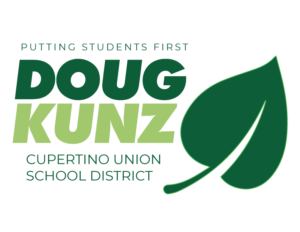ISSUES
One of the the things that differentiates Doug is his depth of knowledge on the policy issues facing CUSD. We think if you hear what he has to say in his own words, you’ll also want to see him put his thoughtful approach to evaluating issues and crafting solutions into service for providing a great education to our district’s kids!
The issues listed below are ones where we have received questions from members of the community. If you don’t see an issue that’s important to you, reach out using one of the methods on the Contact page! We would like to know what’s on your mind.
ACTIVE TRANSPORTATION
I believe that promoting active transportation to schools is integral to the health and safety of our students, community and climate. Active transportation to school furthers multiple worthy goals such as fostering student physical fitness, independence, and academic performance, while reducing vehicle traffic and emissions around schools. I chaired the PTA’s “Safe Routes to School” committee for 4 years at my kids’ elementary school, and would be proud to build on that work in office.
My top active transportation-related priority as a CUSD board member would be to adopt a Board Policy that lays out a more comprehensive vision of what CUSD’s Safe Routes to School program should look like and thus sets the table for further progress. A useful local example is the Fremont Union High School District’s Board Policy AR 5142.2, 4b, which specifically includes a strategy for “[w]orking with local government agencies to make operational and physical improvements that reduce or eliminate hazards, such as reducing motor vehicle traffic speeds in the area and establishing safer and fully accessible crosswalks, walkways, trails, and bikeways.” Adopting a policy like this would clearly establish that it is within the Board’s duties to take advocacy stances on projects that affect travel routes to CUSD schools, and thus position the Board to play an active role in these important policy conversations. I support ensuring that CUSD provides convenient, secure bike storage at all sites. I support educating kids about how to bike safely as an important life skill that will benefit their long-term physical, mental and financial well-being while safeguarding our climate. Finally, as an individual Board Member I will personally support City actions that make student travel to schools safer and more convenient. I already have a track record of doing this, including making public comments that supported the Lawson Middle School Bikeway Project in Cupertino, and lowering Sunnyvale’s speed limit to 15mph around schools.
LANGUAGE IMMERSION
There is evidence that language immersion programs have benefits far beyond becoming fluent in an additional language. Problem solving, memory and attention all benefit from early exposure to language immersion. Beyond that language-specific benefit, there is a level of understanding and connection that develops through the cultural exposure in such programs, which can strengthen ties to one’s own heritage (if applicable) and develop a sense of global awareness in those exposed for the first time. The District is justifiably proud of the Cupertino Language Immersion Program (CLIP), which makes Mandarin immersion available as an option, and I support continuing to make CLIP a success.
I see value in exploring adding instruction in the Simplified Chinese writing system, both in terms of giving students more opportunities to use their language skills from CLIP out in the world, and in terms of helping all families who use Mandarin at home to have a language immersion program that reflects their linguistic heritage. If this would also have the benefit of encouraging families to continue with CUSD, rather than opting for private programs offering instruction in the Simplified Chinese writing system, even better.
That being said there are practical considerations to be worked out and we want to be sure to preserve the strengths of the existing CLIP program and the community it already serves well. Key questions include: What would be the cost to the district? How much complexity would it add for the teaching staff – is it practical to offer instruction in both systems? How many students would be expected to take advantage of this offering and how many would be students who wouldn’t otherwise participate in CLIP? These factors and others would need to be addressed by district staff as part of considering what an offering might look like, and ultimately by the board in deciding whether to proceed.
